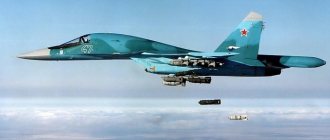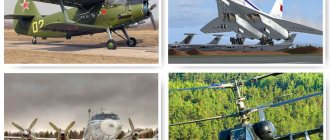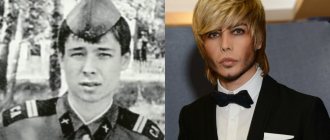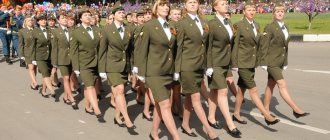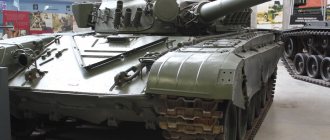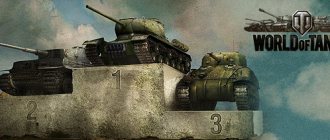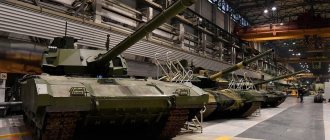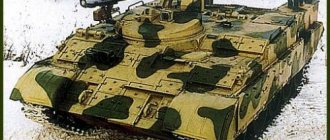In 2005, engineers from the Sukhoi Design Bureau decided to continue developing the Su-35 (T-10BM) fighter, serial name Su-35S. This fighter was supposed to be a deeply modernized, ultra-maneuverable, multifunctional fourth-generation model. The superiority over aircraft of the same class is due to the presence of fifth-generation fighter technology. The first flight took place in 2008 in February.
New implementations on the plane:
- a modernized airframe with a reinforced structure (vehicle life increased to 6000 hours or 30 years);
- no mechanical wiring of the empennage (adjustment using fly-by-wire control);
- an updated KSU-35 was installed (performs the functions of several systems simultaneously);
- additional function - active safety.
Since the Su-27 was the basis for the new aircraft, much of it was used on the new fighter. But at the same time, serious work was carried out to modernize the aircraft. The Su-35 design lacks the traditional upper brake flap, the front landing gear is two-wheeled, and the landing gear has been significantly strengthened due to the increased take-off weight. The plane does not have a PGO, the tail section is shortened. Significantly reduced radar (visibility) due to the reduced area of the vertical tail. Compact avionics helps reduce the volume of the cockpit compartment. The cockpit canopy has changed.
Modernization of the design contributed to an increase in fuel quantity by 20%. Two additional fuel tanks of 1800 liters each are also installed. They are suspended from wing points. Additionally, for long periods of time in the air, a hose-cone refueling system is installed. But the main difference from the base model is the installation of new AL-41F1S engines developed by NPO Saturn.
From a design point of view, these engines are an in-depth development of the AL-31F series. They differ from the base with a new fan increased by 3% in diameter, updated low and high pressure turbines, and an improved digital control system. A nozzle with a controlled thrust vector is provided. The result is increased engine thrust - by 16%.
Among other things, the Su-35 was equipped with an auxiliary gas turbine generator-propulsion unit VGTD TA14-130-35 with a power of 105 kW. It ensures condensation of the compartments and cabin, while supplying them with electricity.
The basis of the integrated on-board equipment is the information-controlled system - IMS. It carries out functional, logical, information and software linking of the main equipment into a solid integrated system. It is she who ensures the interaction between the equipment and the crew. Composition of the ICS: computer for conversion and switching, display system - “glass cabin” concept.
Two multifunctional color LCDs of the MFI-35 type, consoles with a display processor and display control, and a wide-angle coloratura-type indicator against the background of IKSh-1M glass represent the information and control field of the Su-35 cockpit. MFI-35 indicators with a diagonal of 15 inches and a resolution of 1400 x 1050 pixels are used to receive information, process it and display it on the screen for the pilot. Multi-window mode includes graphic, alphanumeric and symbolic display of information.
The multifunctional remote control simplifies the work of managing the issuance of necessary tasks and information. The KISH-1M indicator is used as an observer on the rear side of the cockpit, the field of view is 20 x 30. Thus, on the Su-35, control of all systems, on-board equipment and weapons is carried out according to the HOTAS concept.
Weapons control is done through a radar control system with an Irbis-E phased array antenna. It was developed at the JSC Research Institute of Instrument Engineering named after V.V. Tikhomirov." “Irbis-E” became a continuation of the “Bars” radar control system, which was used on the previously created Su-30MKM and Su-30MKI. This radar system allows you to identify and track about 30 air targets and simultaneously attack 8 of them. The selection of ground targets varies in the range of four units, but subject to complete control of the airspace. Accordingly, the Irbis differs from the base in its expanded operating frequency band, increased detection and tracking area, increased range and improved noise immunity.
In addition to the radar control system, the OLS-35, an optical-location station, is responsible for controlling weapons on the aircraft. It combines a heat direction finder, a television channel and a laser rangefinder-target designator. And to carry out special operations in air-to-surface mode, an optical-electronic container is installed on the Su-35. It houses a laser-television sighting station capable of detecting, tracking, determining the range and providing laser illumination of a target.
The aircraft uses 10 hardpoints to launch missiles and another 2 nodes are used to house electronic warfare. The Su-35's armament consists of 8 R-27ER1 air-to-air missiles, designed for medium-range targets. R-27EP1 and R-27ET1 missiles are placed in 4 units. RVV-AE - 12 pieces, R-73E - 6 melee missiles.
The air-to-surface missiles include 6 tactical missiles Kh-31A (in some modifications Kh-29L), 6 anti-radar and anti-ship missiles Kh-31P and Kh-31A and 5 updated long-range anti-submarine missiles Kh-59MK. Among the new weapons are the Kh-58USHE extended-range anti-ship missiles, 3 Club missiles and one heavy Yakhont extended-range anti-ship missile. Additional weapons include adjustable KAB-500Kr (OD) television-guided bombs, new KAB-500S-E satellite-guided bombs and three KAB-1500Kr (sometimes KAB-1500L) television-guided bombs. The mass of military weapons reaches 8000 kg - 12 external suspension points.
History of the Su-35 prototype
Production began at KnAAPO in 2006. The first prototype was assembled a year later, after which it began flight testing. The Su-35 made its first flight in February 2008, piloted by S. Bogdan. The second and third prototypes began to be assembled in the same year. For 2020, it was planned to create 160 aircraft of this class. By that time, a second prototype had been constructed, which took off for the first time in October of the same year. Exactly a year later there was an announcement about the completed third model. However, already in October, due to a problem with engine control, the Su-35 (3rd prototype) had an accident.
In recent years, the Su-35 has completed a total of 400 flights during all flight tests. On August 15, 2012, the first two prototypes arrived at GLITs for the State Survey. In parallel with them, the first production model of the Su-35S-1 arrived.
As of 2015, the Russian Ministry of Defense received 48 fighters. It is worth noting the exceptional characteristics of the aircraft:
- It is superior to all existing fourth-generation tactical fighters, both the European Eurofighter 2000 and Rafale, and the American F-15, -16 and -18.
- Capable of competing with fifth generation aircraft.
- Considered the fastest fighter.
- Advantage in flight range.
- The only aircraft capable of making a pancake pirouette (a 365-degree turn in a horizontal plane) without losing speed.
The first flight and the first contract for the purchase of the newest fighter
The first prototype took off in mid-February 2008. The Su-35 was piloted by test pilot Sergei Bogdan, showing good results and aerobatics.
The next day, February 20, the newest fighter was demonstrated for the first time to the President of the Russian Federation V.V. Putin in the town of Zhukovsky near Moscow.
By the autumn of the same year, the second prototype of the Su-35 was manufactured at KnAPO and on October 2 it made its first flight in the Far Eastern skies.
During seven months of testing, the second prototype made more than 100 test flights.
At the MAKS-2009 air show, traditionally held in the town of Zhukovsky near Moscow, a contract was signed between the military departments and the Sukhoi enterprise for the supply of 48 new-generation Su-35 aircraft from 2012 to 2015. If the supply contract was completed on time, the parties considered concluding a repeat similar contract from 2015 to 2022.
Preliminary tests were completed a year later, and mass production began in 2010. The first Su-35S fighters saw the light of the third of May and the second of December 2011. The letter C was added to the name of the aircraft, meaning serial production.
According to the contract, by 2013 the Russian Ministry of Defense received 22 of the 48 ordered fighters. Taking into account the fulfilled obligations of the Sukhoi aircraft industrial enterprise under the first agreement and the second similar contract, by 2016 more than 65 Su-35S aircraft had been accepted into service.
Su-35 characteristics:
| Modification | Su-35C (“BM”) |
| Wing size, m | 14.75 |
| Aircraft length, m | 21.95 |
| Aircraft height, m | 5.92 |
| Wing area, m2 | 62.20 |
| Weight | |
| empty plane | 19000 |
| normal takeoff | 25300 |
| maximum takeoff | 34500 |
| fuel | 11500 |
| fuel (with two fuel tanks) | 14300 |
| engine's type | 2 AL-41F1S turbofan engines |
| Thrust, kgf | |
| maximum | 2 x 8800 |
| in afterburner | 2 x 14500 |
| Maximum speed, km/h: | |
| near the ground | 1400 (M=1.17) |
| at high altitude | 2500 (M=2.35) |
| Practical range, km: | |
| distillation room with PTB | 4500 |
| at high altitude without PTB | 3600 |
| at low altitude | 1580 |
| Rate of climb, m/min | 16800 |
| Practical ceiling, m | 18000 |
| Max. operational overload | 9 |
| Crew, people | 1 |
| Weapons: | one 30-mm cannon GSh-30-1 (150 rounds). |
| combat load - 8000 kg on 12 hardpoints: | |
| URVV - R-27E, R-77, R-73, RVV-SD, RVV-MD, | |
| 8 x R-27ER1, 4 x R-27ET1 and R-27EP1, | |
| 12 x R-77 RVV-AE, 6 x R-73 | |
| options: | |
| — 9 x RVV-SD + 2 x RVV-MD; | |
| — 5 x RVV-SD + 2 x RVV-MD + 2 x Kh-31 class strike missiles. | |
| URVP: Kh-31, Kh-25, Kh-29, Kh-38, Kh-58USHKE, Kh-59MK (up to 5 pcs), S-25LD; unguided missiles of types S-8 (in blocks), S-10 (in blocks) and S-25; | |
| Bomb load: 4-5 x KAB-500Kr, 4-5 x KAB-500S-E, | |
| 2-3 x KAB-1500Kr, 2-3 x KAB-1500L or uncontrolled | |
| bombs of various calibers |
Combat aircraft
Avionics
Su-35S fighters are equipped with the N035 Irbis radar system, which easily detects a target at a distance of 400 km. The design is complemented by an optical location station and OEIS. The instrument panel in the cockpit consists of two LCD screens. For greater pilot concentration, a holographic projection is displayed on the windshield.
Modern equipment with a weapon control and use system consists of:
- optoelectronic system;
- functional radar;
- electronic control.
Multi-mode radar with anti-jamming capability allows you to automatically switch to combat mode to attack ground targets. The system is also capable of detecting and tracking an air target at a distance of 400-450 km, and objects on the ground from 200 to 250 km.
The combat equipment of the Su-35 remains exclusive among similar fighters around the world and is capable of hitting:
- marine;
- ground;
- air targets.
More about the aircraft
After numerous upgrades, not one powerful engine was installed on modern aircraft, but two at once. At the very first test, the aircraft was able to demonstrate the development of enormous speed and rapid climb to altitude.
The technical characteristics of the Su-35, the modern electronic equipment provided in the aircraft, and weapons have turned the model in question into what can be said to be the most dangerous adversary for any enemy force that decides to engage in aerial combat with the Russian air force.
Russian Aviation
In the history of our aviation there were two Su-35 aircraft. In the early 90s of the last century, the Su-27M aircraft, factory designation T-10M, which was a radical modernization of the basic Su-27 in the 80s, was demonstrated at international air shows. This was the first attempt to make a multi-role fighter out of an interceptor.
The aircraft was equipped with a new radar, which provided the modernized Su-27 with expanded capabilities for using guided weapons, the weapons control system itself was changed, and to improve maneuverability, the designers installed the front horizontal tail (FH).
In the 90s, with the collapse of the USSR and the subsequent economic crisis, funding for the program was practically stopped, and production of these aircraft was discontinued.
At the beginning of the 2000s, after a change in the country's political leadership, the needs of the domestic air force for new types of equipment were identified and trends in the development of global combat aviation were predicted, which outlined the urgent need for a radical modernization of the heavy Su-27 compared to what was done a decade and a half ago . In order to compete with modern and promising American and European fighters, it was necessary to significantly modernize the entire avionics of the aircraft and its weapons, improve the airframe design and replace the power plant with a more powerful one.
In 2005, when the concept of a modern multifunctional fighter was formulated, they returned to the index “35”, which was assigned to the deeply modernized Su-27. At first, the fighter was designated as Su-35BM - a major modernization, then the name was simplified to Su-35 with foreign buyers in mind. The interest of the Russian Air Force in this vehicle gave impetus to the development of the Su-35S variant - the letter “S” traditionally denotes variants of equipment for supply to the Russian army.
During the design of the new machine, design solutions were used that were tested in the Su-27 and Su-27UB flying laboratories in the mid-1980s.
Experimental T-10-24 with PGO
First of all, it was necessary to decide on the front horizontal empennage (FH), tested on the T-10-24, with a modified remote control system and an in-flight refueling system.
As a power plant, it was decided to install modified AL-31F engines with a thrust increased to 13,000 kgf, and to increase the flight range, use a PTB with a capacity of 2,000 liters. It was also decided to abandon the brake flap and transfer its functions to differentially deflectable rudders.
Especially for the Su-35S, NPO Saturn created a 4++ generation engine AL-41F1C “product 117S” with an afterburner and all-aspect controlled thrust vector (TCV). In January 2008, tests of all five engines of the pilot batch were successfully completed, and by mid-February, ground testing of the aircraft's on-board systems was completed. The installation of a new engine, which significantly improved the maneuverability of the aircraft, made it possible to abandon the front horizontal tail, because controlled thrust vector ensured the aircraft stability and controllability at high angles of attack and at near-zero speeds.
The ultra-maneuverable multirole fighter Su-35S (Flanker-E+) belongs to the “4++” generation of fighters and is designed to intercept and destroy all classes of air targets in long- and short-range air combat, fight for air supremacy, as well as to destroy ground and surface targets. objects covered by air defense systems and located at a considerable distance from the home airfield. The Su-35S uses fifth-generation fighter technology. It can fly and fight in conditions where “classic” fighters of the “4” and “4+” generation cannot effectively conduct combat operations. The “4++” generation is conditional and only indicates that, in terms of its characteristics, this machine is very close to a fifth-generation fighter.
The main goal set by the Ministry of Defense for the Su-35S was to create an aircraft of the transition period from the “4+” to the fifth generation. It was necessary to close the gap between the aging Su-27 fighters, which are gradually being phased out of the Air Force, and the PAK FA T-50 aircraft, which is yet to enter service with the Russian Aerospace Forces, presumably in 2022. For this purpose, the Su-35S has quite high performance characteristics, and in its capabilities it surpasses all 4+ generation fighters, such as the Super Hornet, Rafale and Typhoon, and is capable of withstanding the only fifth-generation serial fighter F today. -22, while being significantly cheaper than the Raptor.
* * *
The first flight model of the Su-35S was assembled at KnAAPO by August 2007. It was transported by An-124 “Ruslan” transport aircraft to Zhukovsky near Moscow, where it was demonstrated at the static parking lot of the MAKS 2007 air show. At the end of the air show and before the start of flight tests, ground testing of the aircraft’s systems and assemblies continued.
The first flight of a prototype of the new Russian fighter took place on February 19, 2008. The aircraft was piloted by Honored Test Pilot of the Russian Federation Sergei Bogdan. On October 2 of the same year, a second prototype aircraft was involved in testing. On April 26, 2009, an incident occurred that, by a happy coincidence, resulted in no casualties.
“At the Dzyomgi airfield in Komsomolsk-on-Amur, while taxiing and running at high speed as a result of leaving the runway, the third flight model of the Su-35 fighter crashed. First class test pilot Evgeny Frolov ejected as usual and was not injured,” this was stated in the official statement of the Sukhoi company.
Witnesses give a more detailed picture of the incident: “Slow taxiing was carried out. The pilot set the engines to afterburner; they did not want to slow down. The sequence of what happened next: fire hydrants, emergency braking, braking parachute, brake failure due to overheating, departure from the runway, ejection. The plane's struts collapsed and it caught fire, but there was no explosion. Burning, it stopped 30 meters from the VOHR booth. The security guard was taken away by ambulance in a state of shock from fright. The pilot escaped with a blow to his butt..."
“Su35-4 burned out. He was jogging, according to the program he turned on the maximum thrust, at the end of the lane at the left engine the thrust does not reset, but remains at maximum. The pilot Evgeny Frolov contrived to turn around (by releasing the braking parachute and burning the brakes), but he was unable to release the gas and, having driven the entire runway, ejected. The plane jumped the heating pipes, broke the landing gear and caught fire 30 meters from the security post (the poor woman was said to have had a nervous breakdown). The reason turned out to be trivial: there was no gap between the engine thrust and the stiffening rib of the removable hatch, which was removed during the engine race, and the “jamb” did not come out.”
In an official statement from the Sukhoi Design Bureau regarding this incident, it was also said: “The third model of the Su-35 aircraft was planned to be connected in addition to the two models already being tested, which have now made more than a hundred flights. Taking into account the successful tests of the existing two flight models, the implementation timeline for the Su-35 program will remain unchanged.”
* * *
The MAKS 2009 air show did not include demonstration flights of the Su-35S in its flight program, but was remembered for the fact that it concluded the largest deal in Russia in recent decades for the purchase of 48 new multirole fighters from 2012 to 2015 inclusive.
In July 2010, it announced the completion of preliminary tests of the Su-35S, full confirmation of the established characteristics of the on-board equipment complex and super-maneuverability characteristics, and its readiness to undergo state tests for combat use together with Russian Air Force pilots.
Acceptance tests of the Su-35S-1 at the KnAAPO airfield, which included seven flights, were successfully completed by mid-May 2011, after which the aircraft was prepared for transfer to the Russian Ministry of Defense to participate in the state joint testing program. The plane was painted in blue-gray camouflage and received tail number 01 with the inscription “Russian Air Force”. On May 28, 2011, the lead model of the new multifunctional Su-35S fighter arrived at the State Flight Test Center of the Ministry of Defense in Akhtubinsk. The plane took off from Komsomolsk-on-Amur to Akhtubinsk on May 27, piloted by Colonel Alexei Pestrikov. An intermediate landing for refueling and rest was made in Chelyabinsk. The next day, May 28, the car arrived at the GLITZ airfield.
A year and a half later, on December 25, 2012, the Ministry of Defense received the first six production Su-35S fighters. By the end of 2015, the Russian Aerospace Forces had 40 Su-35S in service, and at the MAKS-2015 air show an agreement was signed for the supply of another 48 aircraft until 2020.
| Main technical characteristics | |
| Take-off weight, kg: | |
| normal (2 x RVV-AE + 2 x R-73E) | 25300 |
| maximum | 34500 |
| Twin-circuit turbojet engine with afterburner and all-aspect UVT, model AL-41F1C | |
| quantity, pcs | 2 |
| thrust, kg | 14500 |
| Maximum fuel reserve in internal tanks, kg | 11500 |
| Maximum combat load weight, kg | 8000 |
| Service ceiling, km | 18 |
| Flight range with maximum fuel load, km: | |
| H=0, M=0.7 | 1580 |
| Nkr, Mkr | 3600 |
| Ferry range with 2 x PTB-2000, km | 4500 |
| Acceleration time at an altitude of 1000 m with fuel remaining 50% of normal fueling, sec: | |
| from 600 km/h to 1100 km/h | 13,8 |
| from 1100 km/h to 1300 km/h | 8,0 |
| Maximum rate of climb (H=1000 m), m/s | >280 |
| Maximum flight speed: | |
| H=200 m, km/h | 1400 |
| H=11000 m, Mach number | 2,25 |
| Maximum operational overload, g | 9 |
| Take-off run length at normal take-off weight at full afterburner, m | 400-450 |
| Run length when landing on a concrete runway using a braking parachute and wheel brakes with normal landing weight, m | 650-700 |
| Length, m | 21,9 |
| Height, m | 5,9 |
| Wingspan, m | 14,7 |
Armament
- Cannon: 1 × 30 mm GSh-30-1 aircraft cannon, 150 rounds
- Combat load: 8000 kg
- Suspension points: 12
- Armament mounted on suspensions: 8 URVV - R-27RE,
- R-27TE,
- R-77,
- 6 URVP S-25LD,
- X-29,
- X-59M,
- X-31A and P,
- KAB-500Kr,
- FAB-500, -250,
- OFAB-100,
- NAR S-8, S-13, S-25.
Externally, the Su-35S is very similar to the Su-27. It differs from the original T-10M in that it has no PGO, a shorter tail boom, no upper brake flap, and its functions are performed by differentially deflectable rudders. Due to the increase in take-off weight to 34,500 kg, the landing gear was strengthened, and the front support was made of two wheels.
The aircraft's wing is cantilever, the consoles have a sweep angle along the leading edge of 42o, the wing mechanization consists of deflectable flaperons and slats (toes). Flaperons with an area of 4.9 m2 perform the functions of both flaps and ailerons, deflection angles +35o...-20o. Two-section rotating slats with an area of 4.6 m2 are deflected by 30o. The flaperons are released and the slats are deflected during takeoff and landing modes, as well as during maneuvering at indicated speeds of up to 860 km/h.
The Su-35S avionics complex is integrated into the information and control system (ICS) and provides intelligent support for the pilot when using the aircraft’s weapons in a difficult combat situation. The ICS includes two central digital computers, means of switching and converting information, and an indication system that implements the “glass cockpit” concept.
The Su-35S cockpit is equipped with two color multifunctional LCD indicators of the MFI-35 type with a built-in display processor, a wide-angle collimator indicator on the background of the windshield and an aircraft control stick. 15-inch (diagonal 37.5 cm) displays have a resolution of 1400x1050 pixels.
Airplane control stick. 1 – Button to disable the automatic control system (ACS). Also under the pilot’s little finger there is a lever for temporarily disabling the self-propelled guns: while moving on autopilot, the pilot presses the lever and manually performs the maneuver, after which the self-propelled guns continues to guide the aircraft along a new course. 2 – Four-position OBE mode switch for selecting combat and navigation modes of the on-board equipment complex. 3 – Horizontal button. In case of loss of orientation in space, including when feeling unwell after overload, the pilot can press this button so that the aircraft automatically returns to straight-line motion with zero roll and pitch. 4 – Firing button for cannon weapons. The rockets are launched by a trigger. 5 – The “Maneuver-trajectory control” switch switches the aircraft to super-maneuverability mode. 6 – The joystick (joystick) for controlling the marker is responsible for the position of the cursor on the screen. (c) Marina Lystseva, https://fotografersha.livejournal.com/465322.html
The Radioelectronic Technologies Concern has developed a new strapdown inertial navigation system BINS-SP2. The system determines the aircraft's location autonomously without satellite navigation or communication with ground services. The same navigation system is installed on the 5th generation fighter PAK FA T-50.
The Su-35S radar system, within a 100° field of view, can detect targets at a distance of up to 400 km, as well as track up to 30 air targets and simultaneously fire at eight of them. Such capabilities are provided to the fighter by the new radar control system (RLCS) with the Irbis-E passive phased antenna array.
In a wider viewing area of 300°, similar targets are guaranteed to be detected at a distance of up to 200 km in the front hemisphere (against the ground – up to 170 km) and up to 80 km in the rear hemisphere (up to 50 km against the ground). “Ultra-stealthy” targets with an image intensifier of 0.01 m2 are detected by the Irbis at ranges of up to 90 km. The detection range of ground (surface) targets is: for an “aircraft carrier” type target (IEC 50,000 m2) – 400 km, “railway bridge” (1000 m2) - 150-200 km, “boat” (200 m2) - 100-120 km, “installation of operational-tactical missiles” and “group of tanks” (30 m2) – 60-70 km.
For comparison, the AN/APG-77 AFAR of the 5th generation fighter F-22 Raptor has a target detection range with ESR = 1 m² - 225 km in azimuth-speed mode and 193 km in LPI mode (the frequency changes more than 1000 times per second. ), cruise missile (0.1 m²) - 125-110 km. The instrumental range of the radar is 525 km.
Another subsystem for controlling the aircraft’s weapons is the OLS-35 optical-location station, which combines a heat direction finder, a laser rangefinder-target designator and a television channel. The use of modern elemental base, new algorithms and software gives the OLS-35 superiority over the OLS of other aircraft of the Su-27 and Su-30 family in terms of range and accuracy, as well as reliability. The area of review, detection and automatic target tracking by the optical location station is 90° in azimuth and +60°...-15° in elevation. The detection range of an air target by a heat direction finder in the front hemisphere is at least 50 km, in the rear hemisphere – at least 90 km. The laser rangefinder measures the distance to an air target in a range of up to 20 km, and to a ground target – up to 30 km. with a measurement accuracy of 5 m.
In addition, to ensure effective combat use in the air-to-surface mode, the aircraft can be equipped with a laser-television sighting station installed in a container on one of the weapon suspension points. The station provides detection, tracking, ranging and laser illumination of ground targets. With its help, adjustable laser-guided bombs can be used.
Control of on-board equipment, systems and weapons in the Su-35S cockpit is provided by buttons and switches on the aircraft control stick (see above) and engine control levers, as well as push-button frames of multifunction indicators. Thus, the HOTAS concept - joystick - is implemented on the aircraft. The development of indicators and a number of other avionics systems for the Su-35S aircraft is provided by the Ramenskoye Instrument Engineering Design Bureau and other enterprises of the Technocomplex Research and Production Center.
Today (2015-2017) the Su-35S is the most modern Russian fighter, with which only the F-22 Raptor can compete in its combat capabilities, and in terms of super-maneuverability characteristics it has no equal.
Updated (February 2016): On January 30, 2016, due to the worsening relations between Russia and Turkey, four Su-35S fighters were transferred to the Russian Aerospace Forces Khmeimim air base in Syria. Details here:
- Four Su-35S fighters deployed to Syria
- Konstantin Sivkov: The transfer of the Su-35S to Syria is associated with a new deterioration in relations between Russia and Turkey
